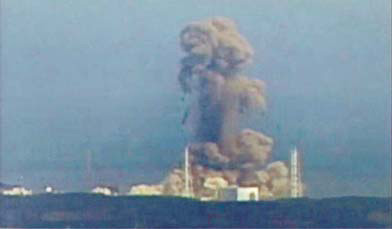Q&A: Nuke crisis raises questions, concerns
|
Smoke rises from a second explosion at Fukushima Daiichi nuclear power complex on Monday. Reuters |
The nuclear crisis in Japan has developed rapidly on many fronts, making it difficult to track the threads. What are the dangers? Will the situation improve? Can the reactors be cooled?
The crisis began on Friday when a magnitude-9 earthquake and tsunami cut off regular electricity to the oldest unit at the Fukushima Daiichi nuclear complex, 270 km northeast of Tokyo.
Since then more reactors - at more nuclear sites - have lost at least some cooling ability, increasing concerns about possible meltdowns.
Some questions and answers about the crisis in Japan:
What is the status of nuclear reactors as of Monday?
A: There are nine units under states of emergency - three at Fukushima Daiichi, three at Fukushima Daini and three at Onagawa. All are north-northeast of Tokyo, along the eastern coast, and all are boiling water reactors.
The other three reactors at Fukushima Daiichi, operated by Tokyo Electric Power Co, were shut before the earthquake. A fourth reactor at Tokyo Electric's Daini site appears fine. There are only three units at the Onagawa facility, owned by Tohoku Electric Power Co. Most concern has been directed at Daiichi units 1 and 3.
What are the worries?
A: At Unit 1, which began operating in 1971, workers are trying to prevent a meltdown, complicated by the fact that a need to release a pressure buildup in the reactor vessel led to a hydrogen explosion that blew off the roof and walls of the containment building. Officials say the reactor vessel is intact but worry about the overheated uranium fuel. In a desperate move, officials have piped large amounts of seawater into the reactor vessel to try cooling the severely overheated uranium core.
On Monday, a hydrogen explosion also hit Unit 3. It was not immediately clear how much, if any, radiation was released. Officials were using seawater to cool the unit, where they believe there has been a partial meltdown.
What is the situation at the nearby Fukushima Daini facility?
A: Japanese officials say units 1, 2 and 4 retained offsite power after the earthquake and tsunami but were experiencing increased pressure inside their containment vessels and equipment failures. As a result, plant operators vented steam at each unit and were considering additional venting to alleviate pressure increases.
And now there are concerns about a third complex?
A: Yes, as of late Sunday, there are states of emergency at each of the three reactors at the Onagawa nuclear site. Officials have said only they've detected higher than permitted radiation levels there.
Any indications of radiation exposure to humans yet?
A: Of the more than 180,000 people evacuated from around the two Fukushima complexes, up to 160 may have been exposed. And at one point, officials said the radiation detected outside the Daiichi Unit 1 in a 1-hour period represented the allowed rate for an entire year.
Exactly what is a meltdown, and why is it potentially dangerous?
A: A meltdown occurs when a reactor's radioactive core, which holds its uranium fuel, gets so hot that it begins to melt. A complete meltdown can breach a reactor's steel pressure vessel and other protective barriers - and spread radioactive byproducts like iodine and cesium into the surroundings. That endangers the environment and nearby residents. However, a reactor will not explode like an atomic bomb.
What steps can be taken to prevent a meltdown?
A: The immediate key is reducing temperatures in all the reactor vessels. Another critical goal would be restoring regular electrical power.
Associated Press
(China Daily 03/15/2011 page10)















